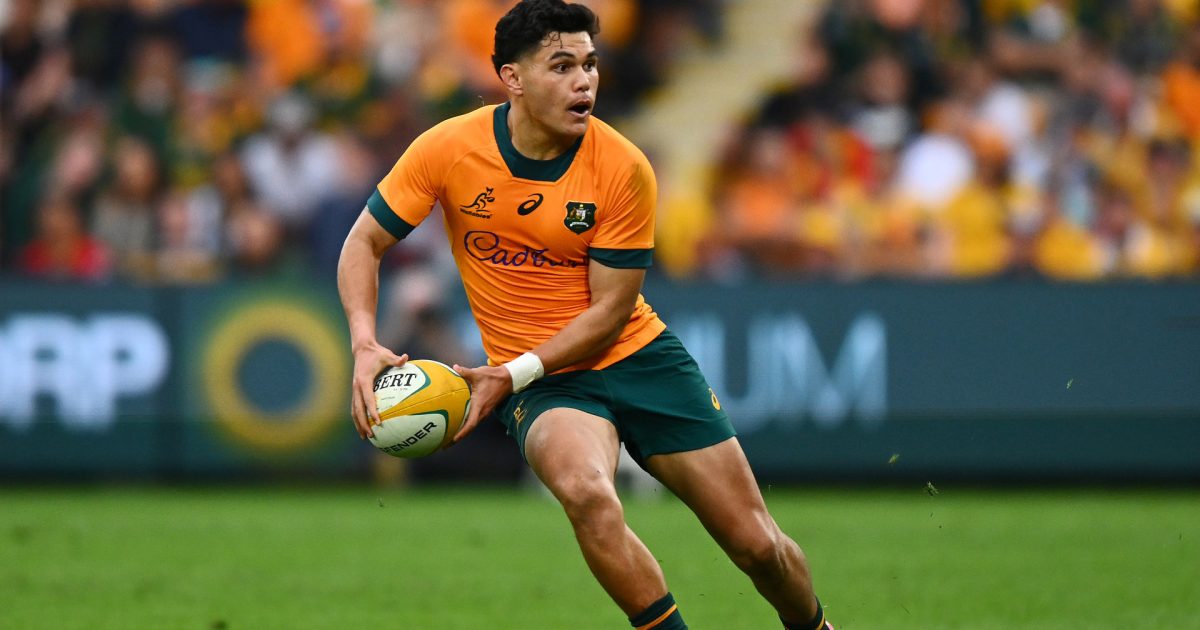
How the Wallabies can expose England’s oppressive linespeed

The Wallabies will face their old foe England in the first Test of their grand slam tour, and those wearing the white jerseys will look to swarm the gold ones from the first whistle.
England’s defensive line speed was aggressive and quick against the All Blacks last weekend and it caused the Kiwis a great deal of trouble, but the defensive system comes with a cost.
The English forwards were carrying heavy legs in the final quarter of the first half and the line speed never regathered its potency as the game drew on, this intel must shape how and where the Wallabies attack.
The Wallabies must be patient enough to wait for the fatigue to set in.
A key aspect of a rush defence is that it requires numbers to do it, rushing with a blatant overlap is not a sound tactic, nor is it something England do.
However, the numbers must come from somewhere and the English don’t fold as much as other sides do to cover the short side.
Often there’s only three players, usually including a tight-five forward, to defend a blindside which is up to 20-metres long.
This aspect of the English game presented itself as early as the sixth minute in last Saturday’s game.
Here, hooker Jaime George, lock George Martin, and inside centre Ollie Lawrence can be seen covering 20-plus metres.
Had Beauden Barrett switched to the blindside with halfback Cortez Ratima and flyer Reiko Ioane, the All Blacks likely would have made good ground, if not scoring a try.
Barrett sees this space but it isn’t until 20-minutes later that the All Blacks decide to expose this defensive habit and it results in a try for Will Jordan, who scores virtually untouched from 30-metres out.
Prop Ellis Genge, winger Immanuel Feyi-Waboso, and fullback George Furbank are again covering a 20-metre blindside against Calbe Clarke, Jordan, and Barrett.
There must be two key take aways from these clips, first, England do indeed sacrifice numbers on the short side to stack their openside defence to allow the rush.
Second, the one place the English defence is most vulnerable is around the ruck.
In any defensive system, the pillar and post, who are the closest defenders to the ruck on either side, should never move.
Their job is to defend against a scooting halfback or an attacker coming back against the grain.
Genge, in the clip above takes the bait and leaves his post to chase Barrett, had he stayed, he would have likely nailed Jordan.
However, he drifts from his post and Jordan goes through.
This is not the rule, it’s the exception, but the point is: no matter what defensive system is being run, you can guarantee the two men immediately next to the ruck are instructed to stay.
The All Blacks exposed both the distribution of players in England’s defensive pattern as explored above and the stagnant defenders around the ruck more often as the game went on.
The English defence comes up-and-in, like an umbrella, forcing players inward, as well as making aggressive tackles from the outside-in, this also draws on numbers who would otherwise be realigning to defend the next phase.
Here’s an example of the All Blacks using their forward pod to tip inwards rather than outwards.
This exposes the stagnant defensive alignment of the pillar and post-defenders identified earlier in the piece.
Scott Barrett tip-passes inside to Tyrell Lomax who then offloads to Cam Roigard.
English reserve prop, Fin Baxter, in jersey 17 is the pillar defender and because he must stay next to the ruck a three-metre gap between created between him and the rushing Alex Dombrandt in jersey 20.
It’s this gap which the All Blacks target and the one the Wallabies should look to utilise as well.
Had Barrett carried this ball, he would have been caught five metres behind the gainline, instead, the All Blacks set a ruck five metres over the gainline.
In the next clip, the All Blacks repeatedly attack the space closest to the ruck, and because the English tackle from the outside-in, it eventually creates an overlap that the All Blacks expose.
The All Blacks pull all their lessons from throughout the game into this sequence of phased and pick-apart the English defence.
First, Tamati Williams tips inside to Scott Barrett which narrows the English defence on the short side.
Next, Jordan runs a tight line between two defenders which pulls Henry Slade from the outside to make the hit with Chandler Cunningham-South.
Finally, Feyi-Waboso is outnumbered on the blind side three-to-one, but he stays in system to a fault and rushes Barrett who gets the ball quickly to his two-man overlap.
The All Blacks make 15-metres just by allowing England’s defence to run its pattern.
These are all valuable lessons for the Wallabies and they must learn from them.
The Wallabies must weather the initial storm of the English rush defence during the first 30 minutes.
It will be an attritional period of the game where they must look to play territory, but learning from the All Blacks’s game is crucial.
Whoever wears the no.10 jersey for the Wallabies must also resist the mirage of space on the outside of the umbrella defence and look inwards.
Little kicks like chips and grubbers can work for variation’s sake but the Wallabies must invite the English defence to rush-up, to achieve the tiring effect as seen in the All Blacks’ game.
Patience is key as even Beauden Barrett was caught almost 20-metres behind the gainline on a couple of occasions, with few options but to carry into contact to secure possession or to hoist a rushed kick for little gain.
The no.10 must also resist playing deeper to give himself more time, the ABs tried this and gained very little.
Changing the point of attack from the openside to the blindside like Barrett did for Jordan’s try is another tactic which could work well.
Noah Lolesio has done this on several occasions for the Wallabies and ACT Brumbies.
It also worked for Ben Donaldson against Argentina earlier in the year, which is a team that also runs a rush defence.
Big ball carriers in-tight will also be crucial to the Wallabies’ hopes of starting the game well but there may be scope to bring in some their strike weapons later in the piece as well.
The All Blacks played their towering lock Patrick Tuipulotu off the bench, and he secured great gainline metres and attracted several English defenders with his carries in the second half.
Joe Schmidt would have taken note of this, and it could be a role for Will Skelton.
The vigour of the English starters may not allow Skelton to get up a head of steam and could nullify his impact.
Regardless of who is selected where, the Wallabies must be ready to go head-to-head with England, because they must tire them out like the ABs did.
The Wallabies are big outsiders for this clash but with the added reinforcements as well as the continued time together in camp, the Wallabies may just surprise the English with their newfound discipline in their game.
The Wallabies can achieve what the All Blacks did as long as they don’t get flustered and acknowledge the storm will pass.







































































The selected side isn’t going to bother England. That’s a very ordinary Wallabies side, let’s be honest with few form players and little X factor. Locks, halves and back three only just Super Rugby quality at best. And Schmidt is now sticking with these guys, worrying times. Bet the tactics along with the selection is poor as well. Schmidt is living in the past.